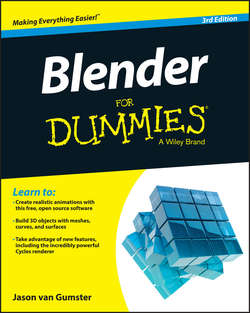Читать книгу Blender For Dummies - Jason van Gumster - Страница 9
На сайте Литреса книга снята с продажи.
Part I
Getting Started with Blender
Chapter 2
Understanding How Blender Thinks
Understanding the Properties editor
ОглавлениеAfter the 3D View, the Properties editor is probably the second-most used editor type in Blender. You use buttons and values in this editor to modify the attributes of your scene and elements within it. Because this editor can manipulate so many parts of a scene, it's broken down and organized into a series of subsections.
You can access each of the various subsections by using the buttons in the header region of the Properties editor. It's worth noting here that these subsection buttons are ordered logically from large contexts (such as Scene properties) to progressively smaller contexts (such as Object Data properties) as you go from left to right. It's also good to know that the available subsections in the Properties editor can change depending on what your active selection is in the 3D View. For example, if you have a camera object selected, the Modifiers subsection of the Properties editor isn't visible (because modifiers can't be applied to cameras). The following list describes each subsection of the Properties editor:
✔ Render: The Render properties determine what the final output of your scene will look like when you decide to render it to an image or video. Chapters 14 and 15 cover these properties in more depth.
✔ Render Layers: You can organize the output of your scene in render layers, useful for compositing (see Chapter 15) different render outputs into a final image. The properties in this section give you control over organizing your render layers.
If you use the Freestyle edge renderer, this section also contains those properties.
✔ Scene: These general properties dictate the nature of your scene, including things like the active camera, units of measurement, and the strength of gravity if you're using simulated physics.
✔ World: The buttons and values in the World properties subsection control the environment that your scene is built in. They have a large influence on the final output of your scene.
✔ Object: Any object in your scene is going to have its own set of properties that you can modify. The Object properties subsection allows you to make changes that affect an object as it relates to the scene.
✔ Object Constraints: When working in 3D – particularly with animation – it's often useful to constrain the properties of one object to that of another. Constraints automate parts of your scene and help make it much more manageable. Chapter 10 goes into constraints more deeply.
✔ Modifiers: A lot of work goes into building 3D models, so it's to your benefit to take advantage of your computer and have it do as much work for you as possible. Let it take care of boring procedural steps like mirroring parts of your object or making it smoother while you focus on the more interesting steps in the process. Modifiers are great tools to facilitate these kinds of healthy shortcuts, and allow for more advanced uses in animation. This subsection is where you manage those modifiers. You can find out more about modifiers in Chapter 5.
✔ Object Data: Like the previous four subsections, buttons and values in Object Data properties change slightly depending on what sort of object you’ve selected, but their primary purpose is to give you the ability to work with the fundamental structural elements of your object.
“Object Data” is a generic term. Think of this section as properties based on what you've got selected. Even the icon for Object Data Properties changes depending on your selection. For example, if you have a camera object selected, these would be Camera Properties and the icon for this section looks like a camera. If you have a curve object selected, the icon looks like a curve and you'd think of this section as Curve Properties.
✔ Bone: The Bone properties subsection is only available if your active selection is an Armature object. Armatures, sometimes called skeletons in other programs, are used for animation in Blender and they consist of a set of bone sub-objects. Bone properties are where you can adjust attributes of a specific bone that you've selected in the armature.
✔ Bone Constraints: Similar to the Object Constraints properties, this subsection helps you manage constraints. The difference, however, is that this subsection is only available if your active selection is an Armature in Pose Mode and it's for managing constraints on bones, rather than objects. Chapters 10 and 11 cover constraints and the use of constraints on bones.
✔ Material: The controls in Material properties allow you to dramatically change the appearance of objects in your scene. Chapter 7 goes into this subsection in much more detail.
✔ Texture: Textures can have a profound effect on how the surface of your 3D objects appear, making smooth, clean objects look rough, gritty, and believable. You can also use textures as custom brushes when painting and sculpting in Blender. This subsection is where you can edit those textures. You can find out more on texturing in Chapter 8.
✔ Particles: In computer graphics, particle systems are often used to create special effects or manage the behavior of groups of objects. This subsection of the Properties editor is where you manage particle systems in Blender. Working with particles is a pretty advanced topic. Chapter 13 gives you a brief introduction to the possibilities that they have.
✔ Physics: In the spirit of making your computer do as much work for you as possible, having the computer simulate physical behavior in your objects is sometimes helpful. It lends realism to animations and can often help you work faster. The Physics properties subsection gives you controls for simulating physics on your objects. See Chapter 13 for more on these topics.
